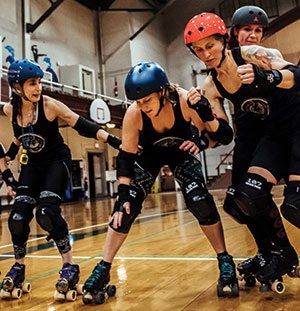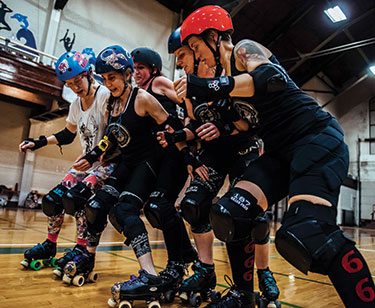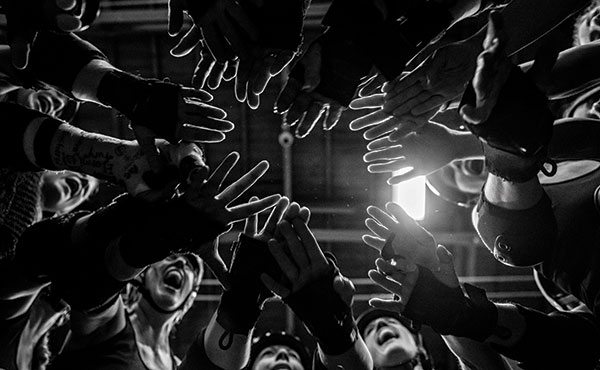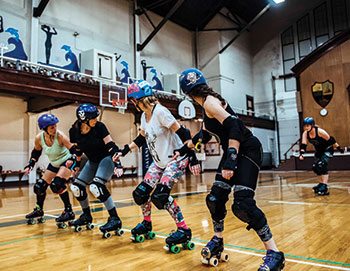More than just a sport for these women
Written by Dan Marios | Photography by Lauryn Hottinger
There’s nothing unusual about the day jobs of this select group of women.
One works in a children’s library and another is a physical therapy assistant. There’s a resource room teacher, full-time homemaker, a professional photographer, and someone who works with developmentally disabled youth.
And for those willing to discuss their age, they are in their mid-20s to mid-30s.
When this group finishes their workday, they all become united in the same profession – roller derby skaters for the Androscoggin Fallen Angels, the first women’s flat track roller derby league in western Maine.
 According to rollerderbyresource.com, the sport has its origins in the banked-track roller skating marathons of the 1930s which morphed into professional events in the 1940s. In the following decades, it predominantly became a form of sports entertainment where the theatrical elements overshadowed the athleticism; with pushing and shoving episodes, gratuitous showmanship, and bitter rivalries which often resulted in slugfests.
According to rollerderbyresource.com, the sport has its origins in the banked-track roller skating marathons of the 1930s which morphed into professional events in the 1940s. In the following decades, it predominantly became a form of sports entertainment where the theatrical elements overshadowed the athleticism; with pushing and shoving episodes, gratuitous showmanship, and bitter rivalries which often resulted in slugfests.
The flat track version of the sport evolved in 2001, allowing play on any flat surface that is suitable for skating, such as the Lewiston Armory where the Fallen Angels practice. Today’s roller derby is milder in tone and promotes athletic prowess, while still maintaining the colorful uniforms and player pseudonyms. The Lewiston-based team formed in 2015 and put the call out for women who wanted to join this new venture. Today, the team averages 30 members.
Derby Name: Audzilla
Audrey Gilmore is 33 years old and has been one of the team captains since joining the derby last November.
“I like to do things that are strenuous, like long distance hikes and backpacking trips. I seek out anything that pushes me out of my comfort zone physically and mentally,” said Gilmore. “Roller derby does that to me on a weekly basis, and I love it.”
Gilmore says that she rollerskated as a kid and figure skated on ponds in the winter. In her adult years, she has wanted to join a team because “that’s where growth occurs. I’ve always enjoyed working in groups and achieving goals with other people.” When she heard about the league forming, it sounded both fun and challenging.
“Roller derby is hard. The skills we are learning are complicated, painful at times, and overall very difficult,” said Gilmore. “After a tough practice you just look around at the others, all as sweaty and stinky as you, and know that you’re accomplishing something and going somewhere together.”
 Derby Name: Wild Violet
Derby Name: Wild Violet
Krista Lord is 34 years old, married, with two kids. She lives in Lisbon Falls but grew up in Lewiston.
Like Gilmore, Lord rollerskated often as a kid, at the Rollodrome in Auburn and outdoors. “I loved it and I even owned my own skates.” She explains that she was never into sports, and the only types of exercise she enjoyed were yoga and hiking, which can be very solitary.
“When I saw that this team was recruiting, I was very much in need of a change. I was going through a rough time, and the idea of belonging to a team, trying new things, and becoming more physically active felt like just what I needed.”
For Lord, the team is a lot about empowerment.
“Derby makes me feel like a badass. The fact that I went from not being able to skate at all, to jumping, crossing over, and skating backwards, has given me an incredible sense of accomplishment.”
 Derby Name: Min Diesel
Derby Name: Min Diesel
Mindy Lee Güngör says she’ll discuss anything except her age. As for her involvement in roller derby, Gungor says, “My husband and my kids will agree that derby is the best thing that’s happened to me since they all came into my lives.”
“I enjoy the superb camaraderie as well as the physical fitness and the immense feelings of empowerment,” said Güngör. “The skills for derby are so varied and complicated that we could essentially all be concentrating or struggling with different skills at the same time. I feel like the derby culture is defined by the overwhelmingly supportive environment necessary to accomplish those goals as an entire team.”
Güngör believes that while many team members have demanding jobs or relationships outside of derby, there is always someone there who understands you and can uplift you.
“Derby has become an extended family for me that I never knew I could have acquired,” she said. “And my family enjoys hearing stories about derby. My youngest has even chosen a derby name: Sprinkled Gumball Machine.”
Derby Name: DeManda Ransom
Amanda Comeau says that her age is completely irrelevant to doing roller derby, but does admit to having five children from ages 2 to 20. In addition to managing her family, she works from home running the business of a small medical office.
“At the (roller derby) recruitment meeting I attended, someone said, ‘Derby finds you when you need it,’ and she was right,” said Comeau.
“I’ve never been on a sports team, ever. I’ve never been an athlete, not even close. A year ago I was overweight and out of shape, but I was determined that if I was going to be on this team, I was going to do whatever I had to do to earn my place,” said Comeau, admitting that she started paying attention to the way she fueled her body and that she started really pushing herself during her off skate workouts.”
“I’ve lost 60 pounds this past year and I’m in the best shape of my life,” Comeau says proudly. “On days when I wasn’t motivated to do it for myself, I did it because of my commitment to be my best for the team.”
Stereotypes Dismissed – Empowering Today’s Women
Family members and friends are supportive of the derby women but still have recollections of televised derbies from decades ago.
“My parents were freaked out when they found out, especially my dad,” said Lord. “At first, he still had the roller derby of the 1970s in his head. I had to explain that it isn’t like that anymore, and that no one would be pulling my hair out.”
Gilmore hears the same stereotyping.
“Most people think it’s cool but some think I’m crazy,” said Gilmore. “It’s a flat track and there’s no punching or elbowing people in the face. People think of the banked tracks and getting thrown over the railings. I constantly have to tell people it’s not like that.”
Comeau captures the essence of the Androscoggin Fallen Angels that goes far beyond the sport itself.
“Being part of this team is so much more than roller skating. We support each other on and off the track. In our short time together as a team, we’ve really bonded,” said Comeau. “When our lives get crazy, we often turn to each other and there’s nothing like a circle of strong women who have your back. Derby love is real and good and it cures whatever ails you.”
“I’m doing more than I thought I could and finding a sport I love in the process,” adds Sabrina Yocono of Lewiston, who admits that until this past May, she hadn’t been on roller skates for 25 years. “Success at practice translates off the track as well. It’s empowering to tackle new challenges and I take those ‘wins’ with me into the rest of my life.”
Editors Note: Currently, the Androscoggin Fallen Angels have no matches open to the public. They are still working toward competition level skills and expect to schedule games in 2017.
For info: afarollerderby.com.

Rules of the Game
The basic rules of roller derby are simple.
The object of the game is to score the most points by lapping opposing team members on the track. A roller derby game is called a “bout.” Each bout consists of multiple “jams.” A jam is a two-minute period in which teams attempt to score points.
TEAMS
There are 5 players on each team:
1 Jammer – the point scorer
3 Blockers – playing defense
1 Pivot – plays defense, but is the leadership position in the pack, calling the shots.
In order to tell the skaters apart, the jammers wear a helmet cover with a star and the pivot wears a striped helmet cover.
The pivot and the blockers make up the pack. Their job is to stop the opposing team’s jammer from breaking though the pack and scoring, all the while helping their own jammer advance.
GAME PLAY
Derby is played on an oval track with two competing teams. The pivots and blockers from both teams skate together on the track to form a single pack. Once the last pack member skates 30 feet from the starting line, a whistle is blown and the jammers begin to skate.
The jammers must skate and muscle their way through the pack and completely exit it to gain the ability to score points. Once the jammer makes her way out of the pack, she then races around the track to lap the pack. At this point, each time the jammer passes a member of the other team, she scores one point for her team. The first jammer that legally passes through the pack first wins the status of lead jammer.
A jam ends when the two-minute time period is over or the lead jammer calls off the jam.
Rules of the Game provided by rollerderbyresource.com.
Dan is an actor, producer, writer, and editor. As owner of Mystery for Hire, he has performed in nearly 900 mystery dinner theater shows. With Mainely Improv, Dan does improv comedy performances, as well as corporate training in using the skills of improvisation. |
While he serves as editor and writer for many publications, Dan particularly enjoys crafting stories that reflect the LA Metro area.


 Derby Name: Wild Violet
Derby Name: Wild Violet Derby Name: Min Diesel
Derby Name: Min Diesel